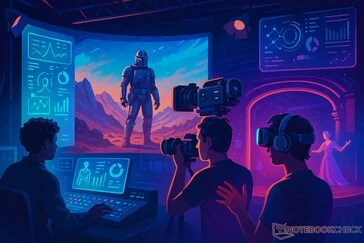Key Takeaways
1. Virtual Production Revolution: Virtual production, exemplified by The Mandalorian, allows filmmakers to shoot on digital sets with real-time adjustments, making the process more adaptable and economical.
2. Stagecraft Technology: Stagecraft merges high-quality digital environments with physical sets, enabling quick scene changes and reducing the need for location shoots and expensive physical sets.
3. AI in Script Evaluation: AI tools like ScriptBook assess scripts based on story elements rather than cast or director data, emphasizing the importance of narrative in predicting a script’s success.
4. Post-Production Enhancements: AI technologies, such as Adobe’s Sensei, automate video editing tasks, allowing editors to focus on storytelling while speeding up the editing process.
5. Immersive Theatre Experiences: The integration of AR and VR in live performances, as seen in the Royal Shakespeare Company’s productions, creates interactive and immersive theatre experiences for audiences.
Real-time technology is changing the entertainment world, impacting both film and theatre in ways that were once thought impossible. Leading this change is virtual production, a technique that enables filmmakers to shoot on digital sets with immediate adjustments. This provides a more adaptable and economical option compared to conventional filming methods. The technology, most notably showcased in the Disney+ series The Mandalorian, is altering the way stories are presented on screen.
The Impact of Stagecraft
The Mandalorian made a mark by using Stagecraft, a state-of-the-art virtual production system created by Industrial Light & Magic (ILM). Stagecraft brings together expansive, high-quality digital environments and actual sets, allowing filmmakers to create scenes that seem to occur in far-off places without leaving the studio. This innovative tech allows for quick changes to virtual settings, greatly minimizing the need for location shoots or costly physical sets.
Jon Favreau, who created the series, shared that his work on The Jungle Book and The Lion King led him to believe “there had been breakthroughs in game-engine technology that were the key to solving this problem.” Favreau saw that the real-time features of these tools could significantly alter the filmmaking method by enabling directors to visualize and modify their scenes instantly on set. This results in a smooth blend of physical and digital components, eliminating many limitations associated with traditional production.
AI’s Role in Filmmaking
Artificial intelligence is also transforming the creative side of filmmaking. According to The Guardian, ScriptBook’s AI mainly evaluates scripts without depending on cast or director data. “Most people believe that cast is everything, but we’ve learned that the story has the highest predictive value,” said Nadira Azermai, the company’s founder. The software can evaluate over 400 aspects in just six minutes, including emotional analysis, journeys of protagonists and antagonists, structural elements like the three-act format, and audience appeal. Even though cast details can improve precision, Azermai notes that “if the computer says no to begin with, no additional information will change it to a yes.”
Advancements in Post-Production
In post-production, AI is also breaking new ground. Adobe’s Sensei AI, part of Adobe Premiere Pro, helps video editors by automating tasks such as trimming and organizing footage according to mood, pacing and rhythm. AI takes care of much of the technical workload, allowing editors to concentrate on storytelling and creative choices. This speeding up of the editing process lets films be finished on tighter schedules without sacrificing quality.
Theatre has also jumped on the real-time technology bandwagon. Companies are increasingly using digital innovations like augmented reality (AR) and virtual reality (VR) to enrich live performances and craft immersive experiences. The Royal Shakespeare Company (RSC), for example, used AR in its 2016 production of The Tempest, working with Intel and Imaginarium Studios. This show featured a vibrant digital backdrop that reacted to the actors’ actions in real-time, including a digitally created storm that altered the stage experience for the audience.
New Formats in Theatre
The innovation has also spread into immersive formats. In 2021, the Royal Shakespeare Company introduced Dream, a digital theatre initiative based on A Midsummer Night’s Dream. This production utilized motion capture and gaming technology to create a computer-generated forest. Actors performed within a designated space, and the system translated their movements onto avatars instantly. Audiences participated remotely and helped shape the environment. This project opened up new avenues for experiencing theatre.
Lastly, live-streaming remains a strong tool for broadening access to theatre. The UK’s National Theatre has launched a new worldwide streaming platform, making its celebrated productions available to viewers across the globe. This initiative not only creates new revenue streams but also democratizes access to high-quality theatre, allowing audiences to enjoy compelling performances beyond the physical stage.
Source:
Link




Leave a Reply